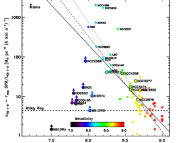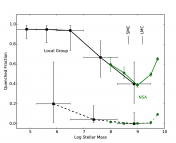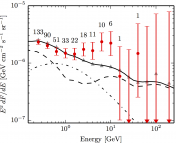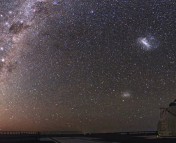- Title: Charting Unexplored Dwarf Galaxy Territory with RR Lyrae
- Authors: Mariah Baker, Beth Willman
- First Author’s Institution: Haverfold College
- Status of paper: Submitted to ApJ
Smaller but Not Lesser
Galaxies come in many different shapes and sizes. Dwarf galaxies are the most common type of galaxies in the Universe. Compared to the Milky Way and other normal-sized galaxies that house hundreds billions of stars, dwarf galaxies typically only boast of several billions of stars. As a result, they have smaller masses and lower surface brightness (a measure of luminosity averaged over pixels area, in units of mag/arcsec2). These dwarf galaxies hang around larger galaxies and are good companions to their larger and more massive counterparts. For instance, we currently know of 43 dwarf galaxies that orbit our Milky Way (the Small and Large Magellanic Clouds are Milky Way’s most massive dwarfs, for instance) and ~50 that are contained within the Local Group, with membership belonging mostly to the Milky Way and Andromeda.
What is so interesting about dwarf galaxies that people are so keen in finding them? Besides being interesting from their sheer number, dwarf galaxies are non-negligible players in the cosmology playground: they are more dark-matter dominated than larger galaxies and are laboratories to test dark matter theories. One of the recurring obstacles to the normative cosmological model we adopt, known as LCDM (Lambda Cold Dark Matter), is the overestimation of Milky Way dwarf galaxies predicted from simulations compared to observations, also known as the “missing satellites problem“. Simulations also predict some massive dwarf galaxies to host more dark matter than we observed, another cosmology buzzword known as the “too big to fail” problem. In the hope of resolving these cosmological issues, dwarf galaxies are scrutinized more carefully and the expedition to uncover more dwarfs is more vibrant than ever.
A New Way of Looking
So now we’re pumped up to go and search for more dwarf galaxies. But wait. Current search strategies (which searches for dwarf galaxies by resolving stellar populations) restrict us against finding low surface brightness and low Galactic latitude dwarfs, a factor that could have contributed to the “missing satellites problem”. Figure 1 illustrates the biases in current dwarf search methods. Fainter dwarfs are just more difficult to find while the increasing number of foreground stars at low Galactic latitudes hampers dwarf searches in this region of the sky. This paper proposes to use a special type of variable stars, RR Lyrae (RRL), as tools for discovering faint and low Galactic latitude dwarfs.

Fig 1 – Left plot shows size versus luminosity for confirmed (closed points) and new (open points) dwarf galaxies in the Milky Way, while right plots shows luminosity versus distance for the same points. Notice the dearth of faint dwarf galaxies on the upper left corner in the left plot and the lack of distant dwarfs on the lower right corner in the right plot. These show that current search methods work best in finding close-by and bright dwarfs, but are biased against distant faint dwarfs. [Figure 1 in paper.]
What is this group of stars so exotically named, you ask? RR Lyrae (RRL) is a class of short-period (0.2-1 day) variable stars found in old and metal-poor populations. They have light curves that are easy to distinguish and are good distance indicators, having their intrinsic luminosity already well-determined. Because the Milky Way halo consists mostly of old stellar populations, RRL are particularly abundant there. This is where it gets interesting: At least one RRL star has been found in each known (low-luminosity) Milky Way dwarf (see this earlier paper). Based on this informed premise, single RRL star is hypothesized to be indicators of extremely low luminosity dwarfs; this paper investigates the detectability of dwarf galaxies using RRL in simulations and ranks performance of time-domain surveys in RRL (and thus dwarf galaxies) discovery.
Groups of RR Lyrae as telltales of Dwarf Galaxies
To assess the improvement in discovery rate of faint dwarf galaxies using RRL, the authors simulated RRL spatial distributions in tens of thousands of fake dwarf galaxies. They then searched for groups of 2 or more RRL, which is the minimum group number to effectively search for dwarf galaxies at halo distances (ie, at d > 50 kpc). Figure 2 shows the detectability of simulated dwarf galaxies as groups of 2 or more RR. Notice that huge portion of white in the figure? This means that a larger portion of discovery space at low surface brightness and low Galactic latitude can be opened up using this method of identifying dwarf galaxies as groups of RRL.

Fig 2 – The detectability of simulated dwarf galaxies as groups of 2 or more RR Lyrae stars, as a function of size (x-axis) and luminosity (y-axis). The detectability of dwarfs is also dependent on how common we think RRL stars occur; left plot is for less common while right plot is for more common occurrence. The blue closed and open points are confirmed and new Milky Way dwarfs while the red dashed lines indicate constant surface brightness. Identification rate of low-surface brightness dwarf galaxies through RRL is high, as shown through the white regions. [Figure 7 in paper.]
The authors searched RRL catalogs in the hope of uncovering new dwarf galaxy candidates. Although their search is partially limited by the incompleteness of the catalogs, they managed to find two RRL groups that are not known to be associated with any Milky Way structures. Follow up of these two groups via deep imaging would be required to confirm their natures. Additionally, the authors also rank the performance of current time-domain surveys in terms of dwarf galaxy discovery using this RRL method. Among current surveys, PanSTARRS I (Panoramic Survey Telescope And Rapid Response System) may be our best hope. Its survey region includes a large area at low Galactic latitude and it is deep enough to reveal low surface brightness structures. With PanSTARRS I, we hope to find ~15% of Milky Way dwarf galaxies. Looking ahead, LSST (Large Synoptic Survey Telescope) would crush all existing surveys in discovering new dwarf galaxies. It is wide enough, fast enough, and deep enough to find ~45% of all Milky Way dwarfs and would constitute the most complete possible census of the Milky Way dwarfs, according to the authors’ prediction.
In efforts mining for new astrophysical objects, astronomers always strive for completeness and efficiency. In this case, a complete and unbiased sample of dwarf galaxies would enable all sorts of interesting statistical studies, especially in terms of resolving the “missing satellites problem” mentioned in the beginning. Exploiting RRL as proxies for dwarf galaxies, the authors proposed a new way to find low luminosity and low Galactic latitude dwarf galaxies which current search strategies are biased against. Based on studies of dwarf detectability mentioned above, this method should unveil more dwarf galaxies, especially via PanSTARRS I and LSST. However, it would be interesting to see how many we actually find using this neat little method.




